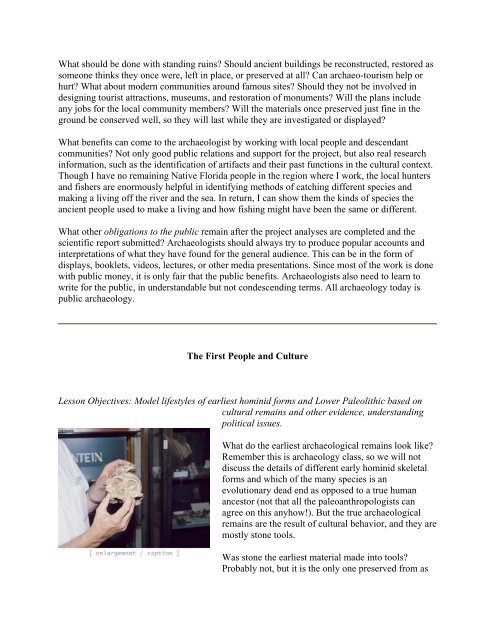INTRODUCTION TO ARCHAEOLOGY Nancy White - Touro Institute
INTRODUCTION TO ARCHAEOLOGY Nancy White - Touro Institute
INTRODUCTION TO ARCHAEOLOGY Nancy White - Touro Institute
Create successful ePaper yourself
Turn your PDF publications into a flip-book with our unique Google optimized e-Paper software.
What should be done with standing ruins? Should ancient buildings be reconstructed, restored as<br />
someone thinks they once were, left in place, or preserved at all? Can archaeo-tourism help or<br />
hurt? What about modern communities around famous sites? Should they not be involved in<br />
designing tourist attractions, museums, and restoration of monuments? Will the plans include<br />
any jobs for the local community members? Will the materials once preserved just fine in the<br />
ground be conserved well, so they will last while they are investigated or displayed?<br />
What benefits can come to the archaeologist by working with local people and descendant<br />
communities? Not only good public relations and support for the project, but also real research<br />
information, such as the identification of artifacts and their past functions in the cultural context.<br />
Though I have no remaining Native Florida people in the region where I work, the local hunters<br />
and fishers are enormously helpful in identifying methods of catching different species and<br />
making a living off the river and the sea. In return, I can show them the kinds of species the<br />
ancient people used to make a living and how fishing might have been the same or different.<br />
What other obligations to the public remain after the project analyses are completed and the<br />
scientific report submitted? Archaeologists should always try to produce popular accounts and<br />
interpretations of what they have found for the general audience. This can be in the form of<br />
displays, booklets, videos, lectures, or other media presentations. Since most of the work is done<br />
with public money, it is only fair that the public benefits. Archaeologists also need to learn to<br />
write for the public, in understandable but not condescending terms. All archaeology today is<br />
public archaeology.<br />
The First People and Culture<br />
Lesson Objectives: Model lifestyles of earliest hominid forms and Lower Paleolithic based on<br />
cultural remains and other evidence, understanding<br />
political issues.<br />
What do the earliest archaeological remains look like?<br />
Remember this is archaeology class, so we will not<br />
discuss the details of different early hominid skeletal<br />
forms and which of the many species is an<br />
evolutionary dead end as opposed to a true human<br />
ancestor (not that all the paleoanthropologists can<br />
agree on this anyhow!). But the true archaeological<br />
remains are the result of cultural behavior, and they are<br />
mostly stone tools.<br />
Was stone the earliest material made into tools?<br />
Probably not, but it is the only one preserved from as
















